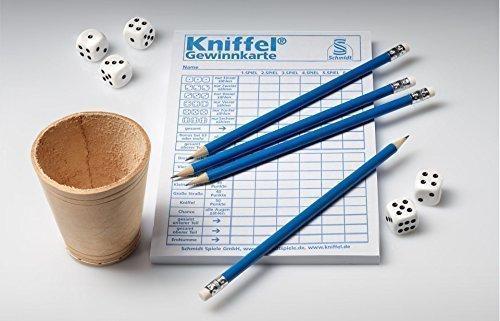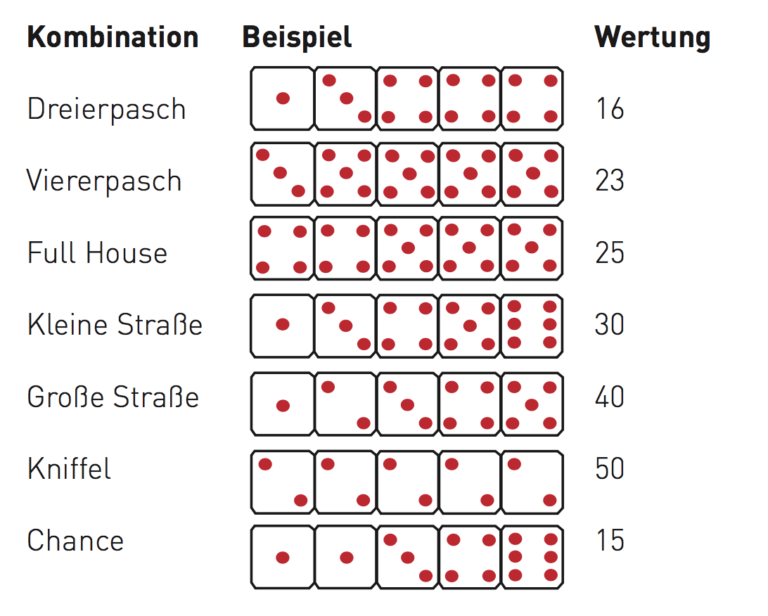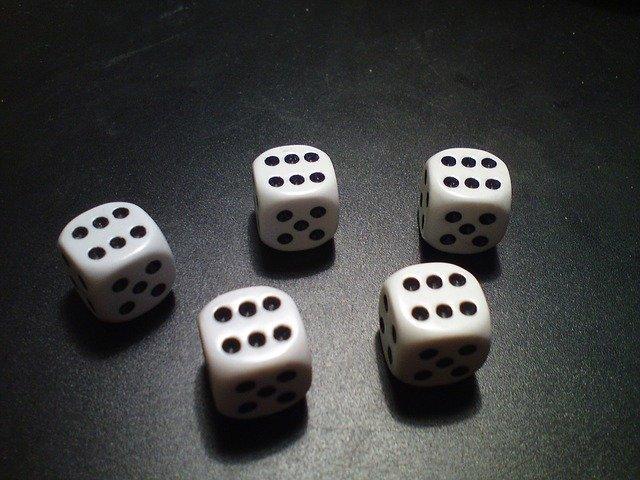The following game instructions and rules serve to get to know each other and are intended to provide a brief overview of the dice game procure. Perhaps it even tempts one or the other to play.
Rules & instructions
At the beginning the starting player is determined. To do this, each player in turn rolls the dice once and the participant with the highest value can open the first game. If you have decided to play several games in a row, the starting player changes clockwise – you should then agree on a fixed game limit before the start so that there are no discrepancies later (the “number of players = the number.” of the games ”recommended).
Kniffel rules of the game
Lost instructions?
No problem, you can download the rules of the game for free from us:
Download the instructions as a PDF for free
Data & facts
| Info | Daten |
|---|---|
| Spielalter: | ab 8 Jahren |
| Spieldauer: | ca. 20-60 Min. |
| Spieleranzahl: | 2-8 Spieler |
| Spielart: | Würfelspiel |
| Ersterscheinung: | im Jahr 1972 |
| Spieleverlag: | Schmidt Spiele |
Dice game for young and old
Kniffel is one of the most famous games and is somewhat reminiscent of dice poker. The rules are simple and can be varied as desired – tricky situations are guaranteed.
In principle, any number of people can take part, but it is advisable to keep a limit of 2 – 8 players. Otherwise there is a risk that an endless game will develop out of it and the fun will fall by the wayside. The winning cards or the game slips are usually only preprinted for a maximum of eight players.
Understanding the rules
The recommended minimum age of 8 years should be taken into account, as the game also demands a lot of thinking and tactics from the participants. Small children will quickly lose interest and become frustrated and angry if they are not successful in the game. Gamblers and tacticians, on the other hand, will experience exciting and entertaining hours with this dice game.
Advanced players also often change the rules and so try other game variants – an extract from the possible changes will be presented in the course of this text. There are no limits to the variety and creativity in terms of new rules and the creation of new game situations. But here, too, the following applies: too many changes can impair the flow of the game and the fun factor of Kniffel.
The game material
You need 5 dice, a dice cup (you can of course also play without a cup or alternatively use a cup-like container), a pre-printed kniffle block (a labeled slip of paper is also sufficient) and a pen to enter the dice results achieved.
The winning card is printed on both sides. On the front you will find a name field at the top. This is followed by the so-called “upper table”, which is numbered horizontally from “Game 1” to “Game 6” and vertically shows the columns “only count ones” to “only count sixes”. The list of vertical fields is supplemented by the columns “total”, “bonus at 63 or more” and “total upper part”. This is followed by the “lower table”, which horizontally resembles the “upper table” and vertically contains designations for 6 special throws, a “chance field” and 3 accounting fields. The back is used to count your own points and, as a control, to count the other players' points.
Game preparations
At the start of the Kniffel game, each participant is given a prize card. First your own name is entered on the front and the names of all players in the corresponding fields on the back. The 5 dice and the dice cup are provided and a game master is appointed. This supervises the correct course of the game of Kniffel and checks the entries of the other participants in the course of the game. So that the burden of the game management does not just rest on the shoulders of a single person, this function should always be transferred to the next person on the left after the end of a game.
A pleasant advantage of Kniffel is that it hardly takes up any space and can be played almost anywhere. The only criterion is the presence of a smooth undersurface that enables the dice to be thrown correctly – but as an emergency solution, a coaster or a beer mat, for example, can be used on which the mug and dice can be placed.
Download the instructions as a PDF for free
According to Kniffel's rules, it is a round-based game. Each person has one turn per round and can try their luck with the dice. The whole thing usually takes place in a clockwise direction and in each game round you are entitled to a maximum of 3 throws in order to achieve the best possible result. The game master monitors the orderly process and ensures that no player is ignored. He also checks the number of throws per person and whether these are carried out in accordance with the rules.
Kniffel rules: Throwing sequence
The first roll is made with all 5 dice. The dice cup is shaken and placed so that it can be seen by all participants. Now the player whose turn it is can decide for himself how many of the 5 dice he wants to keep. He sets aside the dice that pass (these must still be visible to all players). The dice that he does not like can be used again for the second roll in order to improve the result of the roll. With Kniffel, this process can be repeated one more time after the second throw. But after the third throw at the latest, the final result is certain and the player must enter this on his winning card.
Of course, according to the Kniffel rules, you can do without a second or third roll if you have already achieved a desired dice image. If, however, the final throwing result does not cover any of the conditions required by Kniffel, a 0 is entered in any line of the Kniffel block. One also says “a box is deleted”. However, the active player decides for himself which box should be marked with a 0.
The points at Kniffel
The awarding of points – the “upper table”
As already briefly described on the previous page, the front of the winning card is divided into an upper and a lower table. In the upper half are the fields for the rolled ones, twos, threes, fours, fives and sixes, plus the bonus field “63 or more”. If a participant has now decided on a throw result in which he only wants to count the same numbers, he must add these, for example all fives rolled – let's take 3 pieces and add the result, here 15, in the corresponding field, here “only five count “.
With Kniffel, however, each box can only be filled with a cube value once, in this example the field for five would be filled out and blocked for further entries. In order to receive the bonus of 35 points at Kniffel, the sum of the added numbers in the upper half must be at least 63. The 35 points are then credited to the bonus field.
Download the instructions as a PDF for free
The “lower table” – special throws at Kniffel
At Kniffel there are also a number of special throws and a chance field, which can improve the number of points. These are entered in the “table below”.
Special throw “triple”
This is achieved when at least 3 dice have the same number. All dice are added together and the final result can be entered in the field “Dreierpasch”. A throwing example: 5,5,5,4,3 gives 22 points!
Special throw at Kniffel “Viererpasch”
This is obtained when at least 4 identical numbers are rolled. The method of counting is identical to that of the three-of-a-kind, all eyes are added up and the result is recorded in the “four of a kind” box.
“Full house”
This is achieved by rolling 3 identical and 2 identical numbers, e.g. 3 threes and 2 fours. There is a flat rate of 25 points for this, and these are also noted in the “Full House” field provided for this purpose.
“Small Street” and “Big Street”
A “small street” means 30 extra points and is a sequence of 4 successive dice with increasing numerical values, the 5th dice can contain any number. In the case of a “Great Street”, the sequence includes all 5 dice and you receive 40 points. These additional points are also entered in the street boxes on the Kniffel winning card.
Second trick or more trick
What happens when you get one second trick has rolled? For every second or further dice, the player enters 50 additional points on the back of the dice block. Then the player has 2 additional options and can use the kniffel as a joker:
- Joker in the upper field: the player may enter a value with the maximum number of points in any free upper field.
- Joker in the lower field: the player may enter a value with the maximum number of points in any free field below.
If the player already has an entry both in his key field and in the relevant number field (in the upper part), then he may use this throw for any other throw of his choice in the lower field. It doesn't matter how the trick was achieved, you can then, for example, register a full house or a large straight.
Litter examples
- “Small road” – 1,2,3,4,6 = 30 points
- “Big Road” – 2,3,4,5,6 = 40 points
Most of the points are provided by the name “ Trick “. A “Kniffel” consists of 5 identical numbers and has a value of 50 points. It is also the last special throw of the game.
The chance field and other trickery
At Kniffel, the table below is completed with the “Chance” field. A player who has not thrown any of the required results can, instead of a 0, add up all the dice and enter the value received as additional points in the “Chance” box. However, this is only possible once and should be chosen carefully.
If a participant throws several dice during a game, he can use them as a joker from the second dice or exchange them for 50 additional points. A kniffel can be used as a joker if a player has already made an entry in the kniffelfeld and in the corresponding number field (with a quadruple the field “only count four”). Now you can convert the throw into a special throw and enter the points in a free special throw box according to the rules described.
In the case of a quadruple, this results in 20 points (5 x 4) for a double and 25, 30 or 40 points (the overall point values) for the full house and the street spaces. If, however, the appropriate number field in the table above is not yet used for another trick, in our example 5 fours, you will receive 50 additional points. These are noted on the back of the winning card under the player's name in the “plus 50 points” field.
In the free number box, here “only count fours”, the value of the dice, here 20 points (5 x 4), is entered. If all special throws and the matching number field have already been taken, a number field in the upper part must be deleted when you press the button again.
Download the instructions as a PDF for free
The end of the game for Kniffel
The dice game is one of the richest variants of games. In addition to local characteristics, an excerpt from the most well-known rule changes is also presented here.
A game ends as soon as the last field of the last participant in the last game (the number of games is agreed at the start of the game) is filled in. Now the points are added up on the winning card and entered on the back of the slip under the respective name of a player. The person who was able to get the most points (don't forget the bonuses for more kniffles and “63 or more”) is the winner. The current game master checks the final results for their correctness and announces the final placements.
It is up to each round of the game whether it adds up the individual game results and uses the overall score to determine the winner (original version), or for the placements after each individual game points according to a fixed point system (e.g. 1-8 points, 2nd – 7 points, 6th – 6 points, etc.). These points are noted and at the end of the game the sum of all points received is the final result of a player.
The advantage of the 2nd system is that the most consistent player over the entire duration of the game will win. The luck factor is minimized, as extremely good dice results and the bonuses are not included in the final bill (a player can throw an above-average number of dice and thus give his opponents no chance!). Skillful maneuvering and a good mix of risk-taking and thoughtful play will lead to victory.
Variants and rules
As already mentioned, there is an almost incalculable variety of rule changes for the dice game Kniffel. These can take on locally colored embossing, they can be country-specific in nature, but also nationally known. The names or designations for the game also differ from place to place or from country to country: the Austrians know Kniffel, for example, under the name “Paschen”, other places may use the original name “ Yahtzee “Used.
St. Gallen variant
A well-known variant in which the Kniffel rules were changed is the so-called “St. Gallen variant ”, better known under the name“ Voller Becher ”. Here the throws can only be made with a full cup: this means that after the first throw, in contrast to the original version of Kniffel, the player is not allowed to put any dice aside. If he is dissatisfied with the result of the throw, he can start again with all 5 dice. The same applies after the second throw. After the third roll, again with all 5 dice, either a result or a 0 is noted. This can of course be done after the first two throws.
Croatian variant
A Croatian variant completely dispenses with the special throws and the chance field. The fields “Maximum” and “Minimum” take their place. A number rolled as high or as low as possible is entered there. At the end of the game, the “minimum” is subtracted from the “maximum” and multiplied by the number from “count only ones”. The result of this calculation quantifies the points bonus gained. Kniffel do not play a role here and are rated as “equal numbers”.
Video too Rules Kniffel Extreme
Trick block
With us you have the opportunity Templates for a puzzle block free to download. The real Kniffel block is available in the shop of Schmidt Games .
Conclusion
Basically they are Kniffel rules easy to understand. If you play modified versions, it looks a bit more complex. Nevertheless, the game is very popular with young and old and is always fun.



